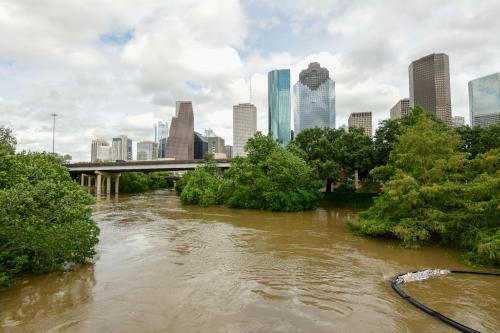The U.N.’s Intergovernmental Panel on Climate Change (IPCC) draft “synthesis report” leaked this week and the findings are almost all dire.
Higher seas, devastating heat waves, torrential rain, and other climate extremes are all intensifying, says the report, according to the New York Times. Runaway growth in the emission of greenhouse gases is overwhelming nations’ relatively weak efforts to limit pollution. And get ready for much worse: Without much more forceful action to curb emissions world-wide, the impacts of climate change in the coming decades will be “severe, pervasive, and irreversible,” says the IPCC.
All in all, it’s a grim story. Except for one thing: According to the IPCC, while national action remains weak around the world, regions and localities all over are taking up some of the slack by taking truly substantive actions to reduce the effects of climate change.
Nowhere is this trend more visible than in the United States. With Congress gridlocked, states and local governments continue to embrace meaningful, sophisticated climate change policies.
Currently 32 states and scores of local governments have plans to address climate change while a few others enacted binding carbon pollution restrictions. In June 2014, for example, Rhode Island became the latest state to join this group after it passed the Resilient Rhode Island Act, which stipulates that greenhouse gas emissions should be reduced 45 percent below 1990 levels by 2035 and 80 percent below 1990 levels by 2050.
Likewise, the nine-state strong Regional Greenhouse Gas Initiative (RGGI) and the California-led Western Climate Initiative further highlight how U.S. sub-national actors have been successfully experimenting with caps on carbon pollution from electric power plants in the absence of a national framework. California’s emission reduction targets are some of the boldest in the nation, and its cap and trade program, which went into effect on January 1, 2013, has been widely considered a success, raising $1.4 billion in its first year.
Even in the area of “climate finance,” as we noted recently on PlanetPolicy, U.S. states and regions are leading the way in the development of creative financing mechanisms—like Connecticut’s and New York’s “green banks”—to advance clean energy development in a period of federal paralysis. Sub-national efforts like these are helping to prototype large-scale climate action. More importantly, at a time of national drift, these actions hold out the only hope of government addressing the impacts of climate change and accelerating the move towards a low-carbon economy.
With that said, the world’s states and regions can’t do it all. Nations are going to have to act more vigorously, including with investments in technology innovation. Not only does the federal government need to enact policies to significantly decrease greenhouse gas emissions nationally but it also needs to partner effectively with states and regions by providing aid and technical assistance. President Obama’s Climate Action Plan and subsequent proposal to cut carbon emissions from existing power plants get some of the architecture right but still fall short of the giant leaps the country needs to take to avoid the worst effects of climate change.
In the meantime, though, U.S. states and regions have emerged as the real leaders in the climate change debate and hold out tremendous promise in the development and implementation of smart climate change strategies.



Commentary
Climate Response Goes Local
August 28, 2014